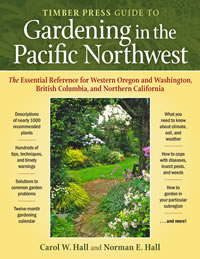 When authors Carol and Norman Hall started gardening in the Pacific Northwest in the 1970’s they had to learn to grow their plants by trial and error, because most gardening books of the time addressed only East Coast weather conditions, such as summer rain and winter freezing.
When authors Carol and Norman Hall started gardening in the Pacific Northwest in the 1970’s they had to learn to grow their plants by trial and error, because most gardening books of the time addressed only East Coast weather conditions, such as summer rain and winter freezing.
However, perhaps it’s just as well the authors had to figure it out on their own because their depth of understanding how the Pacific Northwest climate affects plants is impressive. Although the question of where the boundaries of the Pacific Northwest lie is open to debate, the Halls define them as: the areas stretching between the ocean coast and the Cascade Range, and between latitude 51° in British Columbia and latitude 41° in northern California. The northern boundary was chosen because north of latitude 51° the “difference between high and low temperatures become smaller and light intensity starts to diminish even on clear days… gardening conditions beyond this point are not those of the Pacific Northwest, but those of coastal Alaska.” The southern border seems a bit more arbitrary, especially on the coast, but the authors note: “It’s only after negotiating the steep descent from [the Cascade Range] to the valley floor and seeing the palm trees lining the streets of Redding, California, that you know you’ve suddenly entered a whole new gardening world.” The unifying climatic conditions that defines the region are wet, mild winters and dry summers.
This large format book with 351 pages and a liberal use of color photographs is divided into 4 sections: the region, 12 month maintenance calendar, recommended plants and common problem & solutions.
Detailed descriptions of climate, soils and horticultural conditions are given about the region’s seven sub-regions, which include: the Georgia Basin/Puget Trough, the Olympic Rain Shadow, Puget Sound, Pacific Coast (northern section), Pacific Coast (southern section), the Cascade Slopes/Outflow Valleys and Willamette. The authors recommend their favorite plants that grow well in the Pacific Northwest according to plant types such as: ornamental trees, shrubs, bulbs, and others. Instructions on caring for the recommended plants always refer to specific Pacific Northwest climate considerations. For example, heaths and heathers need supplemental water during our typical regional summer droughts for the first two years, until they become established.
This is an excellent general gardening reference that focuses on the Pacific Northwest climate like no other.
Excerpted from the Winter 2009 Arboretum Bulletin.